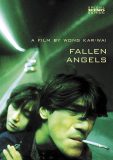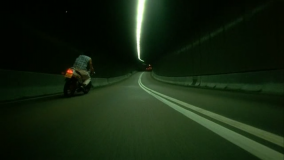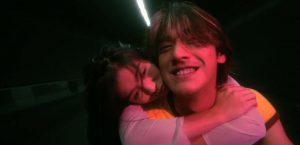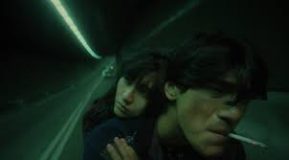Script
AC: Hello, I hope you’re having a good day wherever you may be listening! Welcome to our podcast today for Architecture and Film. We are your hosts today – my name is Amanda.
MX: And I’m Miriam. Today, we’re discussing the film Fallen Angels. This 1995 film directed by Wong Kar Wai captures his signature style of nonlinear narratives with characters yearning for romance and dynamic cinematography showing highly saturated scenes. He has garnered international acclaim, winning the Best Director Award of the Cannes Film Festival in 1997 and has featured as a member of the jury for multiple renown film festivals. Let’s now turn to the synopsis of our movie.
AC: A quick rundown – Fallen Angels is a HK neo-noir crime drama film that tells two interconnected stories, one involving a hitman and a complicated love triangle, the other about a mute ex-con who falls in love with a mentally unstable woman he frequently crosses paths with. The storylines come together in the ending, as the film explores the characters’ loneliness, feelings of isolation, and paths of moving forward. Fallen Angels makes use of incredibly unique cinematography, from the visual aspects – such as neon lights, vignette mood, wide lenses, camera work, tilted angles, handheld camera – to the emotions captured by the narrative work, from the unconventional style, character juxtaposition, and urban angst. Of particular importance is Wong Kar Wai’s use of architecture and spaces to tell a story. In a film where dialogue is limited, the spatial choices he makes are incredibly powerful and greatly impact how we, as an audience, interpret and experience it.
MX: Exactly. And that’s why the location we want to focus on is the tunnel, which makes several appearances throughout the film. Specifically, it’s the Cross Harbour Tunnel, which is the first tunnel in Hong Kong built underwater dating from 1972. Tunnels have always served as a narrative tool in films–as passageways for transportation, they can also symbolize journeys. Fallen Angels makes use of this established narrative tool, as the Cross Harbour Tunnel seems to represent the journey from one phase of life to another.
AC: For sure. The tunnel seems to be central for the mute man’s – He Zhiwu – story, as every scene within the tunnel involves him driving through it on a motorcycle, with a girl sitting close behind him. The first two scenes, I believe, are with Charlie, the girl obsessed with finding “Blondie”, who supposedly stole her ex-lover. In both of these scenes, He is driving for the purpose of helping Charlie, the first being to look for Blondie and the second to bring her to a football game she wants to go to.
MX: I think these first two scenes might symbolize a transition in He’s outlook on life, in particular, with the idea of giving and taking. He is taking from others throughout the beginning of the film, not giving much care to other people’s needs or comfort, only looking out for himself and doing whatever he pleases. He imposes his business schemes, from ice cream van to barbershop, onto others by force. However, by bringing Charlie to where she wants to, he is slowly making the transition to giving. This is highlighted by his view of love using the analogy of a store, where he wants Charlie to stay as long as possible, with him providing her what she wants. Perhaps the tunnel symbolizes this give-and-take relation, as his approach on life is transitioning from one to the other. This transition does revert though, once he realizes that the feelings are not reciprocated. He goes back to his old, abusive habits, like how he cut the hair of a past “customer” against his will.
AC: And the tunnel makes its final appearance in the ending of the movie, when he meets the hitman’s assistant in a restaurant by chance. While unspoken, they seem to connect over the same feeling of loss and emptiness, and he ends up taking her home on the motorcycle. As they drive through the underground tunnel, in a scene evocative of the ones before with Charlie, the voiceovers suggest that there is a silent spark between the two. In this scene, the frenzied camerawork, color grading and slow motion of the two leaned against each other seems to represent an arc of moving forward for them.
MX: I think another really important visual aspect is the overall “grunge” aesthetic not only in the scene, but throughout the film. The grainy shots, the blurry slo-mo moments, the clutter and chaos, are all very present all around, and really add to the mise en scène. It creates a feeling of anxiety and unsettledness, possibly mirroring that of the characters and their quest to come to terms with the uncertainty in their lives.
AC: I agree. On a related note, in the ending scene in the tunnel, the lighting is noticeably green – it’s colorful but dark, it’s face paced but also gentle. The hitman’s assistant, in her internal monologue, says “The road wasn’t long, and I knew I’d be getting off soon. But at that moment, I felt such warmth”. That warmth is a feeling that is not necessarily represented by the scene itself, as green is not a particularly warm color. Here we can see how the setting can contradict with the situation at hand, as the assistant and He are so intimately close, we can feel the warmth and comfort between the two, despite the colder-looking scene. Especially when we compare this scene to the ones before with Charlie, where there is a redder light reflected on the two, the shift in the dynamic is clear despite them being so visually similar.
MX: And when they finally exit the tunnel, that’s when we see the first instance of daylight at the film, as the camera pans up, almost as if they’re offering a glimpse of the “light at the end of the tunnel” for the characters and viewers alike. The tunnel is such an integral part of the story, and it’s really brought alive as the camera not only follows the motorcycle through the emptiness, but also as we listen to the characters thoughts and memories associated with the tunnel. He, in particular, notes important dates of him falling in love, effectively marking the tunnel as a fundamental landmark in his development and story. The tunnel itself becomes a character of its own, as we as an audience become familiar with it and what it represents.
AC: For sure. Another interesting note about the tunnel is that when we visited, we noticed it was just like any other tunnel, and it was filled with cars and noises. But in the movie, it’s late, it’s dark, and the only movement is the unit on the motorcycle. I think the wide camera lens focusing on the characters and distorting the world around them really contributes to the feelings of loneliness and isolation of the characters – that even in such a busy and dense city like Hong Kong, they are still detached from the world.
MX: Right. I think that’s a great conclusion to end with today, and we hope that our discussion has led our listeners to think more about the deliberate spatial decisions made in creating Fallen Angels. Thanks for tuning in!
Amanda Cai (3033112121) and Miriam Xia (3036110916)
Stills

#1 Movie Poster

#2 He Zhiwu riding his motorcycle in the tunnel alone

#3 He Zhiwu and Charlie on their way to the football game

#4 He Zhiwu driving the hitman’s assistant back home
#5 Ending shot of the sky at dawn
Good work! Clear and well-structured elaboration analyzing the narrative of the film and the major architectural element throughout the storytelling – tunnel. I appreciate how you two focus on contrasting how the tunnel was being filmed very differently and gave out different ambiences echoing with the narrative – explaining how the emptiness of the tunnel can be depicted in both warm and lonely manners. It is also great to see how you compare the hustle and bustle of the tunnel when you two visited it at night with the scenes showed in the film.
To further your work, I recommend you to extend your reading on why that particular tunnel was chosen and how/why infrastructure like tunnel, which is generally characterized as emotionless and static, be used in a romance story.